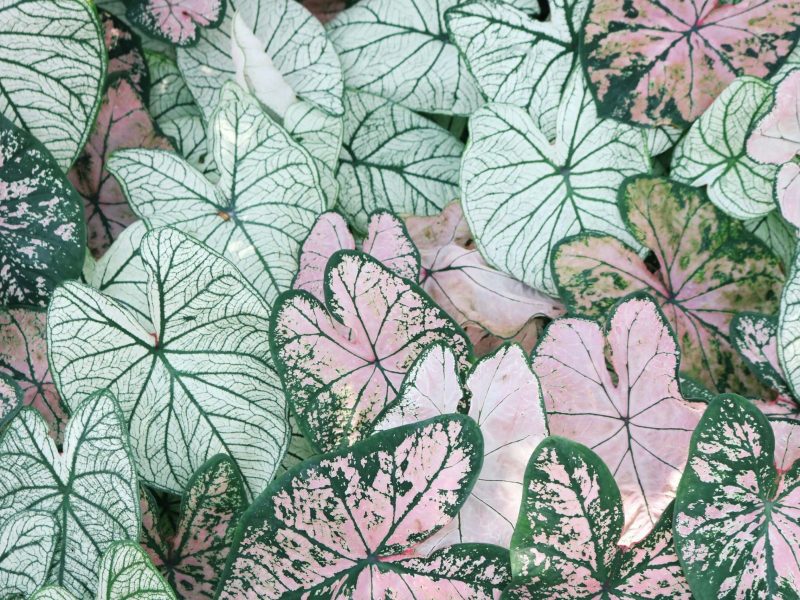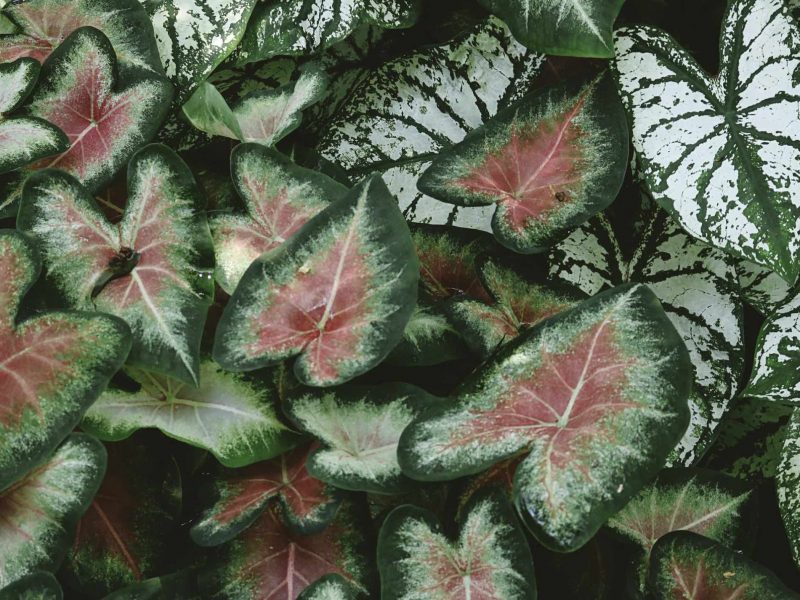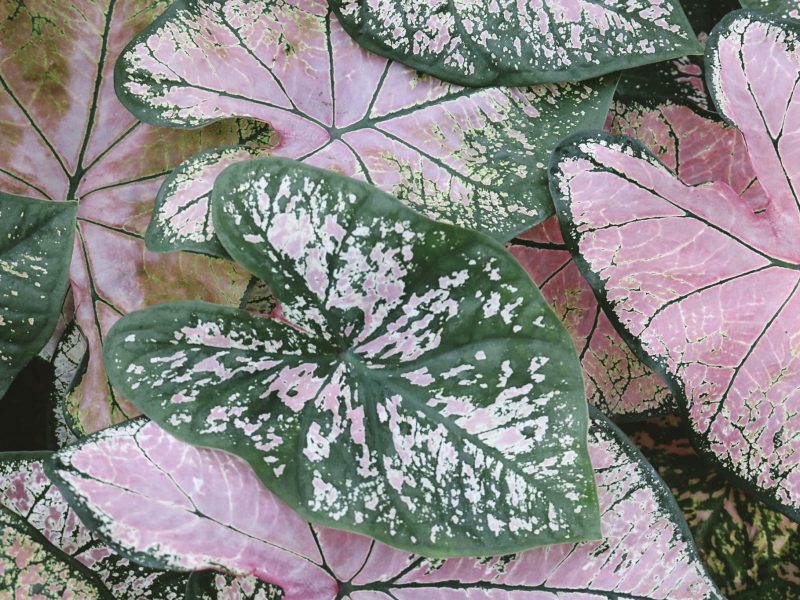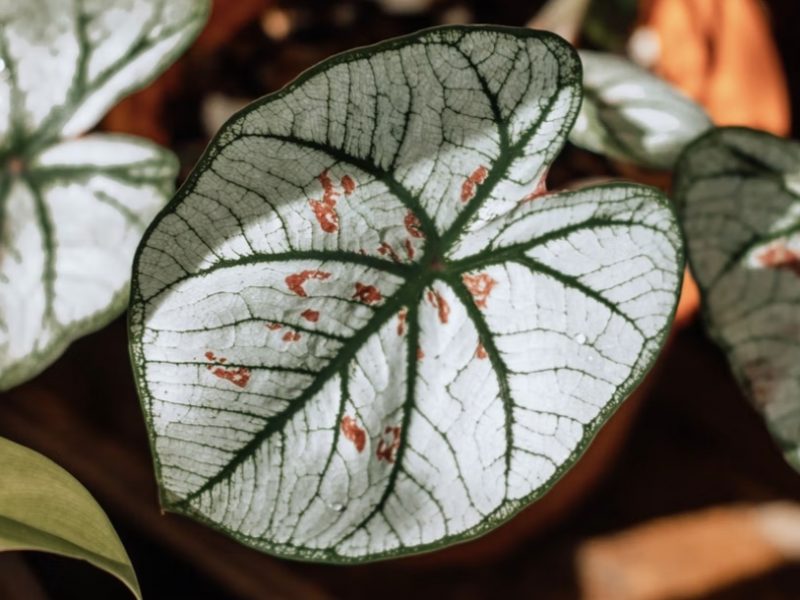
With over 1,000 varieties, plant lovers all around the world are going crazy for Caladium plants! Their beautiful coloured heart-shaped leaves will leave you wanting more and more which is why it’s great that they are so easy to propagate!
In this post we will guide you through the complete process; the various methods you can use, the various dos and don’ts, what tools you’ll need to propagate and things to look out for to ensure you’re successful!
Why propagate a Caladium plant in the first place?
There are several reasons why plant parents might choose to propagate their plants, sometimes it’s more out of necessity rather than choice. Houseplants don’t always grow how we want them to and can often grow sideways, leggy or just too big for your space. But instead of throwing away those cuttings, why not use them to grow a new plant.
If you notice that your plant is looking a little unhealthy and might be dying then sometimes your only option is to propagate a healthy section of the plant and give up on the rest. We will forever recommend that you first try to diagnose the issue and try to fix it but sometimes if there is no positive change, it might be your best and only option.
But it doesn’t have to be all gloom and doom, you may also choose to propagate your Caladium plant to simply make new ones. It can be a great way to multiply the amount of greenery in your home without having to spend a cent. Caladium cuttings also make great gifts for friends and family, especially as they may struggle to get a hold of your specific variety!
Propagating a Caladium can be easy!

What tools/ equipment will I need?
Before you start, It’s important that you have all the right things!
Healthy and mature Caladium plant
Sharp scissors/shears
Spare pot
Fresh soil and water
Newspaper or plastic sheet if propagating indoors
What methods can I use to propagate my Caladium Plant?
Unfortunately, there is only really one proper method; division of the mother plant. This is because the plants reproduce through their tubers in the soil which is why leaf and stem cuttings won’t ever grow new roots.
But luckily using division of your mother plant is not only super easy but it’s very successful too. The new plants will already have a healthy root system and you won’t be waiting months and months for new growth to appear.
The one downside to using the division method means that you’ll need quite a mature plant with several offshoots that you don’t mind separating. They are pretty fast growers, so if your plant isn’t quite mature yet, just wait a few months and come back to it.
Below you will find a step by step guide to the division method:
How to propagate a Caladium plant

How to propagate a Caladium plant through division of the mother plant
Locate the various stems of your Caladium mother plant
When choosing how to divide your plant it will become obvious if there are various offshoots/stems. They will be completely separate and leaves will grow out from each of the stems. If you’re still unsure, follow each of the stems down to the soil so you can see the separate offshoots growing out of the pot.
Take your Caladium out of the pot
This method of propagation requires you to get your hands a little dirty as you need to remove your Caladium from the pot to separate the sections.
Carefully lift your plant out and start to shake off the soil around the roots. An easy way to loosen the potting mix is to gently run your fingers through the roots to start to separate them. This also helps stop too much damage to the root system but don’t worry if you clip the odd root.
Separate the sections
You may have to cut through some of the roots f they aren’t detangling easily but you should be able to carefully pull the sections apart from each other. The most important thing to make sure of is that each section of the plant has a good amount of the root system as this will help them recover quickly from the shock of propagation and repotting and grow new leaves.
It is completely up to you how many new plants you create, and how many offshoots are in each one. It depends on the maturity of your plant as well as your personal preference.
Place in water or fresh potting mix
Pot the main mother plant back into its pot (or downsize if you’ve taken a lot away) and decide whether you want to place your new Caladium plant(s) in water or potting mix.
If the roots on your new plant are still quite small and delicate then you may want to pop it in water for a few weeks to help them mature. However, if the roots system is mature and strong then you can pot your new Caladium plant straight into fresh potting mix.
Use a high-quality potting mix so that your new plants get the right nutrient balance. At first, it can be quite a shock for your plant to be separated and moved into a new pot so good soil will help them develop.
Continue normal Caladium care
Now that your new plant is happily in its new home with plenty of fresh potting mix, your propagation is complete! You can now care for your new plant as you would your mother plant, making sure it gets the right amount of light, warmth, water and humidity to thrive! Soon enough it’ll be big and bushy enough for you to propagate all over again.

Caladium Plant Propagation FAQs
Here are a few of the most common questions we find people have when looking to propagate their plant.
Is it possible to propagate a Caladium from a single leaf cutting?
Unfortunately, it’s not possible to propagate a Caladium from a single leaf cutting. Roots grow from tubers in the soil and a single leaf will very quickly wilt and die if you try to grow it on its own.
Should I fertilise my Caladium cutting?
If using the division method, you can start to fertilise after around 1-2 months. When using stem or leaf cuttings, you’d need to wait a full year but as your new Caladium plants will already have their roots you can resume fertilisation fairly quickly.
Caladiums come in all shapes and colours

Common problems when propagating a Caladium Plant
Although the process can be fairly simple, it will be slightly different each time around and occasionally you might run into some unexpected problems along the way. We recommend keeping a close eye on your new plants to help you spot any early warning signs.
Below we have all of the answers to how to fix any common problems you might run into.
Why isn’t my new plant growing new leaves?
Propagation and repotting can be quite stressful for plants so don’t expect them to all of a sudden be growing lots of new leaves straight away.
If you’re trying to grow your plants when the temperatures are quite low then it’s worth using a heat mat to warm up the area and provide the ideal environment for new growth.
Why are my new Caladium plants losing colour?
If the leaves on your cutting have lost their colour then it’s probably due to a lack of sunlight. Move your new plants to a spot where they receive ample indirect sunlight. Avoid any direct sunlight as that comes with issues of its own.
That’s all there is to know about Caladium propagation. As you’ll need to do it through division, it definitely makes the process easier. With the right care and the ideal environment, you shouldn’t have too many problems.
Check out our full Caladium Care Guide that has all the information on how to continue caring for your plants after dividing them.














